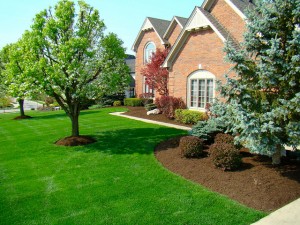 A quick, efficient way to beautify a lawn while protecting trees and plants is to apply landscape mulch. While it may not be glamorous, mulch provides the foundation for the entire landscaped area’s health. A versatile tool, landscape mulch benefits vegetable gardens, flower beds and trees while beautifying and protecting the entire planted area.
A quick, efficient way to beautify a lawn while protecting trees and plants is to apply landscape mulch. While it may not be glamorous, mulch provides the foundation for the entire landscaped area’s health. A versatile tool, landscape mulch benefits vegetable gardens, flower beds and trees while beautifying and protecting the entire planted area.
There are several benefits to using landscape mulch. These include:
- Deters weed growth and makes it easier to pull those that do grow.
- Retains moisture in the soil, preventing plants from drying out and eliminating the need for excessive watering.
- Diminishes the damaging effects of extreme soil-temperature changes. This is especially beneficial during cool spring lows and sizzling summer highs.
- Stops soil from compacting during times of heavy rain. Loose, aerated soil is best for healthy plants.
- Hinders soil runoff from storms and decreases soil erosion so plants retain more moisture.
- Reduces disease outbreaks caused by organisms transferring from soil to plants. These outbreaks occur when disease organisms splash from soil to plant leaves. Mulch acts as a barrier between the soil and leaves preventing transference.
- Adds nutrients to soil benefiting plants, gardens and trees.
- Creates an attractive and refined look for all landscape designs.
Keep in mind these simple rules when applying landscape mulch:
- Before applying a fresh layer in the spring remove the previous year’s layer and add it to the compost pile.
- Don’t over mulch. Too much mulch will trap excessive moisture which may lead to rot, disease and pests. Over use of mulch will also keep moisture from reaching the plant as it will stay trapped in the mulch’s layers. Apply a layer from 2 to 4 inches thick. Be sure the soil below the mulch is no longer visible when application is complete. Be sure to reapply as the mulch deteriorates.
- Apply mulch in an even layer around the base of plants and trees. Avoid creating rounded mounds. Mulch should lie flat and be pulled back several inches from the base of the plant. Extend the layer of mulch past the plant’s drip line – the outermost edge of leaves.
- Don’t forget to water. Watering mulch after it has been applied is an important step. This prevents dry mulch from robbing soil moisture from plants and weighs down light mulch that may otherwise be carried away by the wind.
When the work is done, relax and enjoy the beauty and benefits of a mulched landscaped garden.
If you have any other questions, ask the mulch experts at Melvin Mulch! Call 414-856-9077, we have the lowest prices, guaranteed!
Photo by TownePost Network from Flickr using Creative Commons license